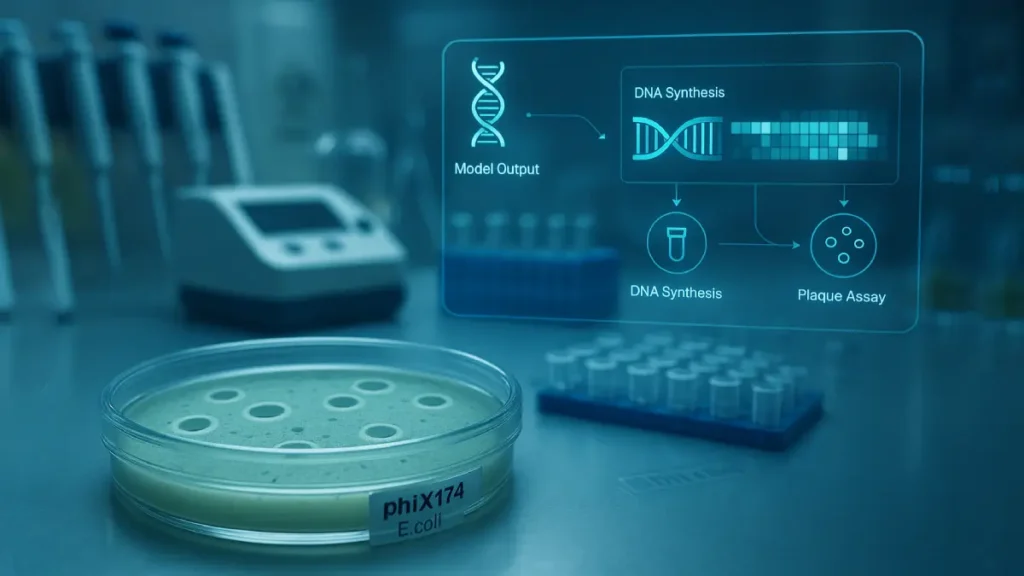The claim that AI created 16 bacteria‑killing viruses in a Stanford‑affiliated lab sounds cinematic. The reality is both impressive and bounded: researchers used generative models to design hundreds of complete bacteriophage genomes based on a minimal, well‑studied phage, then synthesized and tested them—16 worked against E. coli in the lab. That’s a milestone for generative biology, but it isn’t AI conjuring life, nor is it ready for clinics. It’s a faster, data‑driven extension of synthetic biology: propose genome designs and see which boot up.

What actually happened
- A Stanford/Arc Institute team trained generative models on large phage genome datasets to propose de novo designs for the minimal phage phiX174, which has 11 genes and a tiny genome. They synthesized 302 AI‑proposed genomes and tested them in E. coli to see which could replicate and lyse bacteria; 16 produced viable phages that formed plaques.
- The advance is not just in silico novelty but lab‑validated viability: complete, AI‑designed genomes replicated and killed bacteria, a step beyond protein‑only design work, though within a highly tractable viral system.
- Veteran synthetic biologists have framed the work as accelerating existing trial‑and‑error genome engineering with algorithms, not reinventing the field—speeding a known paradigm rather than rewriting it.
Why it matters (without the hype)
- Speed and search space: Generative models traverse huge combinatorial genome spaces to surface viable candidates humans wouldn’t quickly enumerate, compressing design cycles and revealing non‑intuitive gene orders or truncations that still work.
- Therapeutic potential: Phages are regaining attention as precision antibacterials amid antibiotic resistance. The ability to generate many viable, diverse phages could bolster therapy pipelines, address host‑range gaps, and support adaptive cocktails.
- Scientific utility: Multiple functional variants of a minimal phage offer a sandbox to test how gene architecture and regulatory elements influence viability, fitness, and host interactions—helping distill genome‑level design rules.
The careful counterpoints
- Not “AI created life”: Viruses aren’t considered living, and phiX174 is exceptionally simple with decades of literature. Translating this to complex phages, bacteria, or eukaryotic genomes is orders of magnitude harder.
- Hit rate and constraints: A 16/302 viability yield is notable yet modest. Many designs failed to synthesize or boot. The work is tightly bounded to one chassis and a single host, under controlled conditions.
- Safety and misuse: Even with cautious training exclusions, generative workflows aimed at viruses raise concerns if misapplied to human pathogens or engineered for virulence or stability. Governance and guardrails are as crucial as code.
- Generalization risk: Models can overfit training distributions. Claims about “genome‑scale generative biology” require validation across diverse phage families and hosts, with rigorous containment and sequence‑screening protocols.
The system‑level implications
- Pipeline bottlenecks shift: As design becomes computationally abundant, constraints move to DNA synthesis capacity, assembly fidelity, high‑throughput characterization, and biocontainment—all needing scalable, audited workflows.
- Regulatory pressure: Expect updated frameworks for AI‑assisted sequence design, prohibited‑sequence screening, and lab biosafety standards tailored to generative pipelines, extending existing synthetic biology norms.
- Open access vs. risk: Sharing models and designs can accelerate progress but broadens access risks. Responsible openness, staged releases, and third‑party screening will be pivotal.
What to watch next
- Host range and specificity: Can designs target clinically relevant, multidrug‑resistant pathogens with precise host range and minimal microbiome disruption?
- Robust fitness gains: Reproducible improvements over wild phages—thermal/storage stability, biofilm penetration, immune evasion—will determine translational value.
- Safety by design: Built‑in safeguards such as attenuation, conditional replication, and genetic kill‑switches co‑designed with the therapeutic genome would signal responsible innovation.
- Independent replication: External labs validating across different phage systems and standardized benchmarks will separate one‑off excitement from durable capability.
Bottom line
This is a real advance: AI proposed complete viral genomes that were synthesized and shown to kill bacteria in a minimal phage chassis. It is not AI inventing life or an immediate cure for superbugs. It is an accelerated, data‑rich iteration of synthetic virology that unlocks therapeutic promise and serious governance questions. Treat it as a powerful new tool—one that demands careful hands and clear rules.




